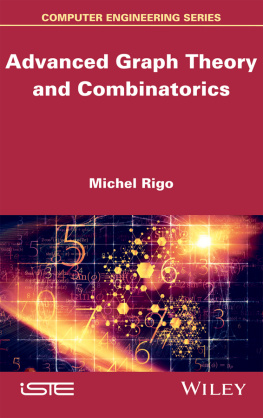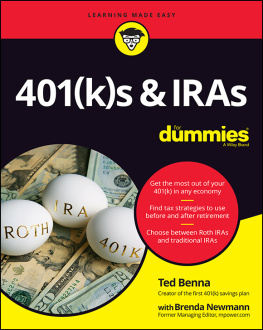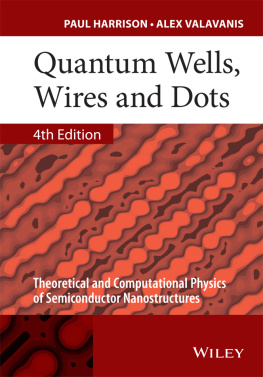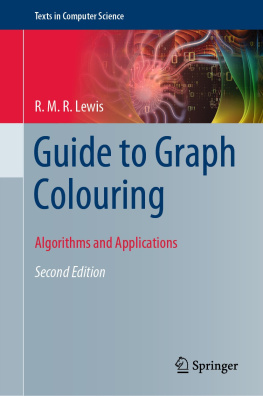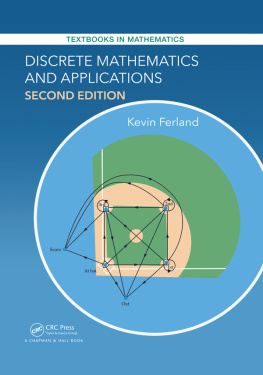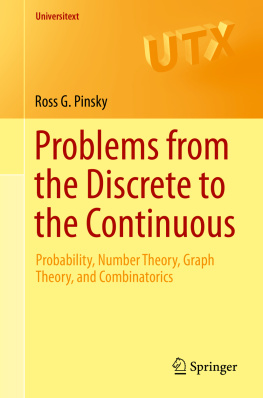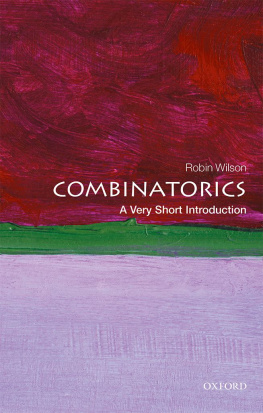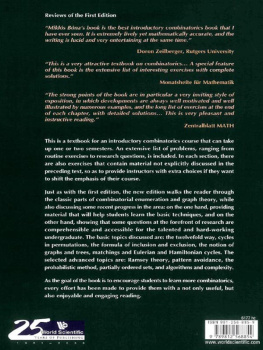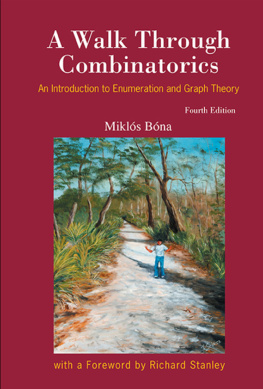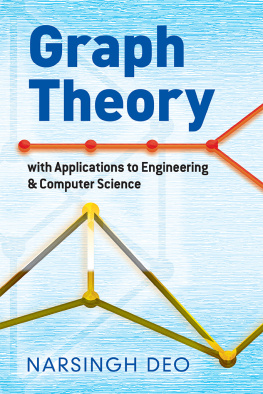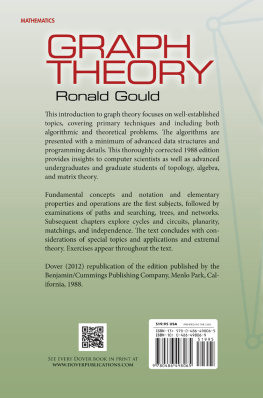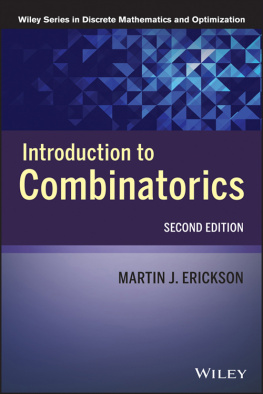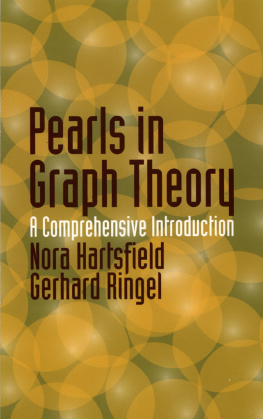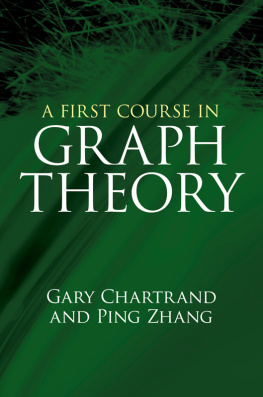John Wiley - Advanced Graph Theory and Combinatorics
Here you can read online John Wiley - Advanced Graph Theory and Combinatorics full text of the book (entire story) in english for free. Download pdf and epub, get meaning, cover and reviews about this ebook. City: London;Hoboken, year: 2016, publisher: John Wiley & Sons, Incorporated;ISTE Ltd, genre: Home and family. Description of the work, (preface) as well as reviews are available. Best literature library LitArk.com created for fans of good reading and offers a wide selection of genres:
Romance novel
Science fiction
Adventure
Detective
Science
History
Home and family
Prose
Art
Politics
Computer
Non-fiction
Religion
Business
Children
Humor
Choose a favorite category and find really read worthwhile books. Enjoy immersion in the world of imagination, feel the emotions of the characters or learn something new for yourself, make an fascinating discovery.
- Book:Advanced Graph Theory and Combinatorics
- Author:
- Publisher:John Wiley & Sons, Incorporated;ISTE Ltd
- Genre:
- Year:2016
- City:London;Hoboken
- Rating:3 / 5
- Favourites:Add to favourites
- Your mark:
- 60
- 1
- 2
- 3
- 4
- 5
Advanced Graph Theory and Combinatorics: summary, description and annotation
We offer to read an annotation, description, summary or preface (depends on what the author of the book "Advanced Graph Theory and Combinatorics" wrote himself). If you haven't found the necessary information about the book — write in the comments, we will try to find it.
Advanced Graph Theory and Combinatorics — read online for free the complete book (whole text) full work
Below is the text of the book, divided by pages. System saving the place of the last page read, allows you to conveniently read the book "Advanced Graph Theory and Combinatorics" online for free, without having to search again every time where you left off. Put a bookmark, and you can go to the page where you finished reading at any time.
Font size:
Interval:
Bookmark:
- 1 A First Encounter with Graphs
- 3 Hamiltonian Graphs
- 4 Topological Sort and Graph Traversals
- 6 Planar Graphs
- 7 Colorings
- 10 Googles Page Rank
- 1 A First Encounter with Graphs
- 2 A Glimpse at Complexity Theory
- 3 Hamiltonian Graphs
- 4 Topological Sort and Graph Traversals
- 5 Building New Graphs from Old Ones
- 6 Planar Graphs
- 7 Colorings
- 8 Algebraic Graph Theory
- 9 PerronFrobenius Theory
- 10 Googles Page Rank

Series Editor
Valrie Berth
Michel Rigo

First published 2016 in Great Britain and the United States by ISTE Ltd and John Wiley & Sons, Inc.
Apart from any fair dealing for the purposes of research or private study, or criticism or review, as permitted under the Copyright, Designs and Patents Act 1988, this publication may only be reproduced, stored or transmitted, in any form or by any means, with the prior permission in writing of the publishers, or in the case of reprographic reproduction in accordance with the terms and licenses issued by the CLA. Enquiries concerning reproduction outside these terms should be sent to the publishers at the undermentioned address:
ISTE Ltd
27-37 St Georges Road
London SW19 4EU
UK
www.iste.co.uk
John Wiley & Sons, Inc.
111 River Street
Hoboken, NJ 07030
USA
www.wiley.com
ISTE Ltd 2016
The rights of Michel Rigo to be identified as the author of this work have been asserted by him in accordance with the Copyright, Designs and Patents Act 1988.
Library of Congress Control Number: 2016953238
British Library Cataloguing-in-Publication Data
A CIP record for this book is available from the British Library
ISBN 978-1-84821-616-7
To Christelle, Aurore and Maxime
The book content reflects the (good) taste of the author for solid mathematical concepts and results that have exciting practical applications. It is an excellent textbook that should appeal to students and instructors for its very clear presentation of both classical and more recent concepts in graph theory.
Vincent BLONDEL
Professor of Applied Mathematics, University of Louvain
September 2016
This book is a result of lecture notes from a graph theory course taught at the University of Lige since 2005. Through the years, this course evolved and lectures were given at different levels ranging from second-year undergraduates in mathematics to students in computer science entering masters studies. It was therefore quite challenging to find a suitable title for this book.
I hope that the reader will not feel cheated by the title (which is always tricky to choose). In some aspects, the material is rather elementary: we will start from scratch and present basic results on graphs such as connectedness or Eulerian graphs. In the second part of the book, we will analyze in great detail the strongly connected components of a digraph and make use of PerronFrobenius theory and formal power series to estimate asymptotics on the number of walks of a given length between two vertices. Topics with an algebraic or a combinatorial flavor such as Ramsey numbers, introduction to RobertsonSeymour theorem or PageRank can be considered as more advanced.
In the history of mathematics, we often mention the seven bridges of Knigsberg problem as the very first problem in graph theory. It was studied by the famous mathematician L. Euler in 1736. It took two centuries to develop and build a complete theory from a few scattered results. Probably the first book on graphs is Theorie der endlichen und unendlichen Graphen [KN 90] written by the Hungarian mathematician D. Knig in 1936, a student of J. Krschk and H. Minkowski. In the middle of the 20th Century, graph theory matured into a well-defined branch of discrete mathematics and combinatorics. We observe many mathematicians turning their attention to graph theory with books by C. Berge, N. Biggs, P. Erds, C. Kuratowski, W. T. Tutte, K. Wagner, etc. We have seen an important growth during the past decades in combinatorics because of the particular interactions existing with optimization, randomized algorithms, dynamical programming, ergodic or number theory, theoretical computer science, computational geometry, molecular biology, etc. On MathSciNet, if you look for research papers with a Primary Mathematics Subject Classification equal to 05C (which stands for graph theory and is divided into 38 subfields ranging from planar graphs to connectivity, random walks or hypergraphs), then we find for the period 20112015 between 3, 300 and 3, 700 papers published every single year.
In less than a century, many scientists and entrepreneurs have seen the importance of graph theory in real-life applications. In a recent issue of Wired magazine (March 2014), we can read an article entitled Is graph theory a key to understanding big data? by R. Marsten. Let us quote his conclusion: The data that we have today, and often the ways we look at data, are already steeped in the theory of graphs. In the future, our ability to understand data with graphs will take us beyond searching for an answer. Creating and analyzing graphs will bring us to answers automatically. Later, in the same magazine (May 2014), E. Eifrem wrote: Were all well aware of how Facebook and Twitter have used the social graph to dominate their markets, and how Facebook and Google are now using their Graph Search and Knowledge Graph, respectively, to gear up for the next wave of hyper-accurate and hyper-personal recommendations, but graphs are becoming very widely deployed in a host of other industries.
This book reflects the tastes of the author but also includes some important applications such as Googles PageRank. It is only assumed that the reader has a working knowledge of linear algebra. Nevertheless, all the definitions and important results are given for the sake of completeness. The aim of the book is to provide the reader with the necessary theoretical background to tackle new problems or to easily understand new concepts in graph theory. Algorithms and complexity theory occupy a very small portion of the book (mostly in the first chapters).
Many other books on graphs do exist and the reader should not limit himself or herself to a single source. The Internet is also a formidable resource. Even if we have to be cautious when looking for information on the Web, Wikipedia contains a wealth of relevant information (but keep a critical eye). The present book starts with some unavoidable general material, then moves on to some particular topics with a combinatorial flavor. Powers of the adjacency matrix and Perron theory have a predominant role. The reader could probably start with this book and then move to [BRU 11] as a good companion to get a deeper knowledge of the links between linear algebra and graphs. See also [BAP 14] or the classical [GOD 01] in algebraic graph theory. Similarly, a comprehensive presentation of PageRank techniques can be found in [LAN 06]. The authors of that book, A. Langville and C. D. Meyer, also specialized in ranking techniques (see [LAN 12]). Another general reference discussing partially the same topics as here and I do hope, with the same philosophy is by R. Diestel where much more material and a particular emphasis on infinite graphs may be found. The present book is smaller and is thus well suited for readers who do not want to spend too much time on a specialized topic.
Font size:
Interval:
Bookmark:
Similar books «Advanced Graph Theory and Combinatorics»
Look at similar books to Advanced Graph Theory and Combinatorics. We have selected literature similar in name and meaning in the hope of providing readers with more options to find new, interesting, not yet read works.
Discussion, reviews of the book Advanced Graph Theory and Combinatorics and just readers' own opinions. Leave your comments, write what you think about the work, its meaning or the main characters. Specify what exactly you liked and what you didn't like, and why you think so.

